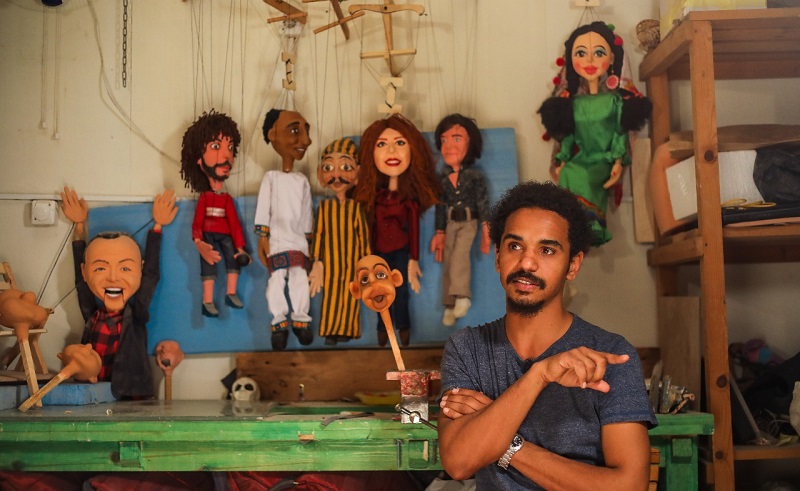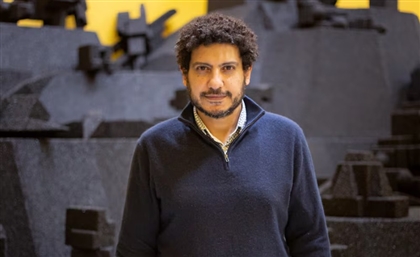Meet the Egyptian Marionette Maker Passionately Sustaining the Dying Art
There’s more to a puppet than just song and dance; it can teach generations as well as it can entertain them.

At one point in time, prolific Egyptian actor Ashraf Abdel-Baqi mentioned that only Czech-made marionettes were employed during any Egyptian theatrical performance that included them, prompting me to wonder why there weren’t any Egyptian marionette makers (marionnettiste). According to Abdel-Baqi’s comments, making a marionette is quite a complex process, requiring dedicated, skilled craftsmen from abroad, but is that truly the case? Or is it just a matter of preference? To find out what exactly the deal was, we met with Mohamed Fawzi Bakkar, a marionette designer and Director of the Sawy Culture Wheel’s Puppet Theatre, to figure out a few things; what goes into making a puppet from the ground up? What’s the industry like in Egypt? What kind of effect or influence does it have on Egyptian audiences? Luckily, Bakkar was a goldmine of insight.
On my way to his workshop – not unlike that of a carpenter – I tried to remember anything about my childhood, and if puppets held much of a place in it. I only came up with two memories; the first was of the glimmer in my mother’s eyes whenever she’d tell us about El Leila El Kebira (The Grand Night), and how iconic of a performance that was to her entire generation. The second was a novel called Hatta Al Lahza Al Akhira (Till the Last Moment); about a lonely marionette maker who would find comfort in talking to his puppets about his problems with anxiety and dealing with people. It escaped me how I could only remember these two memories and not my generation’s own "Puppet Theatre" the reason for which, according to Bakkar, was the absence of puppet theatre from the community.
Limitless Creativity
An artist, their methodology, and their art form are directly affected by the kind of environment they just so happened to be in. Growing up, Bakkar’s surroundings were a massive factor in getting him to where he is now; growing up in the heart of El Wahat’s (The Bahariya Oasis) desert, with nothing to do but bask in the shade of the surrounding palm trees, his flock of sheep and the clay around them. With nothing better to do for fun, and a mind welling with a special brand of creativity, Bakkar decided to see what the clay had to offer; “All the children in El Wahat herd sheep together, it’s just how it is. So, instead of just following suit, I’d lag behind towards the end of the herd, so I could have more time to mould clay into whatever I wanted; a goat, a cow, anything.”
The clay wasn’t Bakkar’s only childhood mentor; he’d often shelter his burgeoning creativity in his school’s art class, “I’d spent almost all my school days there.”
As it stands, there are three schools of art in Egypt; Fine Arts, Applied Arts and Art Education. Bakkar, through sheer circumstance, found himself in the Faculty of Art Education in Zamalek, making a particularly big leap from El Wahat to Cairo. It was there that he’d go through the necessary changes and adjustments he’d have to endure to truly find his craft. He started designing and making his own puppets in 2004 beginning with a puppet modelled after ex-Prime Minister of Egypt, Ahmed Nazif, whose ouster dawned in the January 25 Revolution.
The Birth of a Puppet
Like I said before, Bakkar’s workshop wasn’t at all unlike that of a carpenter; a fact I’d realize after walking into his space. What baffled me, though, was the amount and variety of tools and materials he had; hammers, screwdrivers, brushes, sewing machines and a bunch of strong, what would any of this have to do with making marionettes?
Bakkar could easily see the confusion in my eyes, quickly answering whatever questions I had; “Making a marionette encompasses all schools of art, the designer does everything from A to Z; designing, sculpting, carving, photography, outfit design, décor and even audio.” Pretty neat, but that doesn’t tell you much, so he lay it all out for me to better understand what goes into each and every puppet.
It all starts with an idea, an image of what the designer wants, he’d then draw a preliminary sketch of sorts, after which he’d draw the whole thing in detail, right down to the facial features and the choice of wardrobe, “This process takes us from the rough draft straight to the design template.” The work truly starts after a finished template is made, “we carve out every bit and feature of the puppet by hand, design its outfit, give it a few strokes of the brush and string it up.” The last phase is the demonstration, animating the puppet as if it were just born, they call it the Puppet’s Birthday.

“My relationship with puppets is that of love and affection, all my puppets are my children, and I have no favourites because they all mean so much to me.”
This took me back to the novel I’d mentioned earlier, reminding me of the kind of relationship each designer has with their puppets; something Bakkar has a deep understanding of, saying how his relationship with his creations is “that of love and affection,” seeing as how he spends the majority of his days with them, treating them just like real people, making sure their clothes stay clean, and keeping their little bodies in one piece.
Just like how mothers have no favourites, Bakkar wouldn’t say which of his puppets he loved the most, sufficing it to say “all my puppets are my children, I have no favourites between them, I made them all and make sure they’re safe. They all get the same treatment, and they’re all dear to my heart.”
One of the many things Bakkar had learned from his art education was how to properly deal with his audience, regardless of their age or possible mental disability. Being the Director of the Sawy Culture Wheel’s Puppet Theatre, he hosts performances for young and old alike, so I decided to ask him what the different between both of them was, if any, and which were closer to his heart. “Kids shows are a sizeable responsibility, even if the work is easier,” meaning that his script would have to be on point and educational; making sure that his pronunciation and use of language is kept at a certain standard. “Not to mention the other core elements of a show; like singing, dialogue and the entire entertainment aspect of it all.” With adults, it’s somehow even easier, “they’re already aware of the topics of each show, but the emphasis with adults is the show’s content rather than the theme.”
Do Children in 2018 Care Enough about Puppets?
Bakkar thinks the issue lies with the children’s parents, “would the kids show up on their own? Who really makes the decisions?” In his modest opinion, it all starts and ends with the parent; if they bring their children the first time, and both of them enjoyed it, then whatever decisions about attending again fall to the child, and they’ll certainly want to come again.
Though that last sentence may have sounded like it was full of hot air and nothing much else, Bakkar didn’t leave me too long in the dark about his rationale; “It’s a lot more enjoyable for a child to see a puppet show rather than a cartoon; puppets are real, tangible entities, ones he can meet and talk to after the show, maybe even get their picture taken with it.”

And as for the Good of Men, It shall Dwell on Land
Bakkar decided to talk about the kind of influence that puppet theatre has on the children that decide to show up, deciding to tell me about his most endearing and heartfelt experience with a child. “About a month ago, a kid came up to me after a show, he’d drawn all characters complete with their full names, it was at that moment that I felt like we were capable of reaching out to these kids, leaving a mark on their personalities to come for the better.”
In another instance, Bakkar told one of the children’s parents about his love for the show “The Yellow Frog” – a show about the importance of preserving the Nile – the child had asked somebody about to throw their cigarette butt in the Nile not to do it, so that the water doesn’t get polluted. Not only that, but the child went up to him asking “Why are you even smoking?”
An Underappreciated Craft
There are a lot of hurtful or demeaning terms that people throw around, but none of them seemed to dissuade Bakkar, on the contrary, he’s proud of his craft; taking solace in the fact that his passion in life also happens to be his means to making a living. He reminisced, laughingly, about the times people would call him a “clown guy” or whatever other term to hurt him, wondering what the big deal was. “Puppets sprang out of society as a form of critique on social and political circumstances and events, way back in the Mamluk and Fatimid eras, satirically of course. They were such a success at bringing people together because they would deliver whatever messages or opinions to folks, away from the all-seeing eye of the government – who saw puppets as no threat whatsoever.”
The Real Issues
Even though the Sawy Culture Wheel’s Puppet Theatre has been faring well in recent times, the puppet industry still has quite a way to, if Bakkar has anything to say about it. “Not a lot of people know where they could catch a puppet show, seeing as how there aren’t any festivals or events dedicated to them.” Not to mention how there aren’t any academic establishments where one can learn the craft, “the Cairo Puppet Theatre does exist, and as it stands, it’s our only real bastion in the country, but it’s pretty neglected and people generally try to avoid it; seeing as how the area is filled to the brim with travelling salespeople, it’s not a very safe place.”
Bakkar doesn’t really see any real steps towards changing the puppet situation in Egypt at current, but he has high hopes for a renaissance of sorts when it comes to puppeteering; wishing that one day, puppets and their masters can spread far and wide enough for all to enjoy.
Original article translated from our sister site El Fasla by Ahmed Ikram.
Shoot by MO4Network's #MO4Productions
Photography by Ashraf Hamed
Videography by Tarek El Azizi
- Previous Article The UAE Wants to “Bring Happiness” to Egypt
- Next Article Meet the Egyptian Filmmaker Behind Our First Indie Feature in Cannes
























